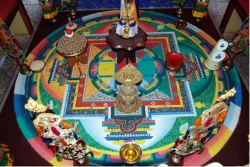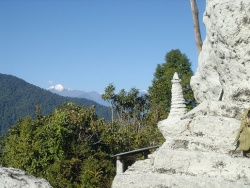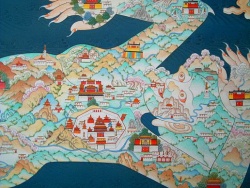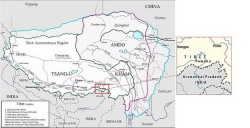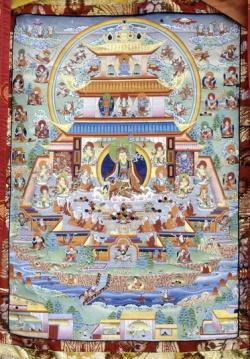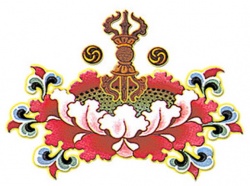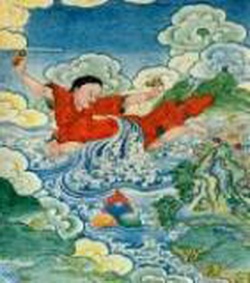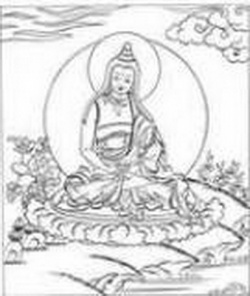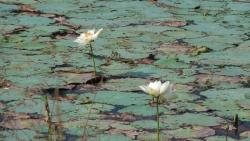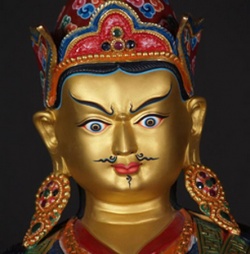Journey to the Hidden Land of Pemako
by Via Naomi Levine
In one of the stamens of the flower of the world is Pemako in the shape of Vajra Yogini lying down. Outer, inner and secret levels correspond to the levels of the mind. In the secret chakra of Vajra Yogini there are flowers coming in winter also. If people die here, they do not take karmic rebirth; they go to the Pure Lands. I do not tell lies. It is like that.
Keep it in mind.
Guru Rinpoche from the Guidebook to Pemako
Pemako is the supreme hidden land, says Guru Rinpoche. Predicting the dark times when the elements will be so imbalanced that it affects meditators, he concealed 108 valleys in the Himalayas as terma or hidden treasure with guidebooks to be revealed at precisely the right time.
Pemako straddles south-east Tibet and extends into the most north-easterly corner of India. The word itself means ‘lotus display’ and is said to be the actual body of Vajra Yogini. From head to navel she is in Tibet; from the navel downwards she lives in India.
The name has resonated in my mind for many years. Stories of trees with edible bark and streams running with milky water, dogs who attain rainbow body by eating the grass, sacred treasure taken from a poisonous lake, magical herbs that induce siddhis and enable realization of emptiness, make it sound like a mythical lost paradise. But, the legend tells also of cannibalistic tribal people in loin cloths with blow darts who guard the hidden land from intruders, poisonous snakes, tigers, leeches and dense jungle. All this makes Pemako intriguing, like a shape shifting dakini.
The renowned explorer-botanist Kingdon Ward, had a less exalted view of Pemako.
Not only is Pemako extraordinarily difficult to reach from any direction, it is still more difficult to penetrate and explore when reached. Surrounded on three sides by the gorges of the Tsangpo, the fourth is blocked by mighty ranges of snow mountains, whose passes are only open for a few months in the year. Beyond these immediate barriers to east, west and south are trackless forests inhabited by wild unfriendly tribes… Add to this… a climate which varies from the subtropical to the arctic, the only thing common to the whole region being perpetual rain, snakes and wild animals, giant stinging nettles and myriads of biting and blood sucking ticks, hornets, flies and leeches, and you have some idea of what the traveler has to contend with.
The Riddle of the Tsangpo Gorges, Kingdon Ward, 1926
Pemako was both heaven and hell. I had to experience it for myself to see my own mind, but how could I get there?
My first attempt was in 1994 when our group of three, led by the translator Gyurme Dorje, got as far as the Guru Rinpoche cave of Thimpei directly below the Doshong-la pass where Kingdon-Ward had made his entry to Pemako in 1925.
It was full moon day as we were walking along the path to Thimpei. The dagger shaped mountain of Namchak Barwa erupted from its white shroud and instantly we saw a rainbow circling the sun.
Inside the cave a massive skylight shaped like a phurba or ritual dagger marked the place where Guru Rinpoche had subdued a demon by throwing his phurba at it. It hit the rock exposing Namcha Barwa, the phurba shaped mountain, at the point where the surging Tsangpo twists around the mountain in a hairpin bend, disappears into the gorge – three times the depth of the Grand Canyon – and after dropping 11,000 metres in an unexplored five mile stretch, emerges serenely into the Brahmaputra in Assam.
This was the heart of the mystery surrounding the inner hidden land. Was there a precipitous waterfall to account for that drop? In The Riddle of the Tsangpo Gorges, Kingdon-Ward described his failed attempt to discover the waterfall which supposedly hid the doorway to the mystical inner level: the fabled Chhimed Yangsang Ney.
After crossing the Tsangpo, we camped on a grassy stretch of land. It was in the late afternoon as we were having tea that a village man appeared dressed in the local style. He told Gyurme Dorje, he had something for ‘the lady’. From inside his jacket he took out a dark object wrapped in a cloth and put it in my hand. It was a black oval stone with a prominent white eye marking its peaked surface and a clear line around the perimeter. ‘This is from my father’s treasure box. When he died he left it with me. I know it’s something special, but I don’t know what it is,’ he said.
As my hand clasped the pitch-black stone I could feel it pulsing as if it were alive. I knew immediately what it was but said nothing. I took out one hundred yuan, placed it in his hand, and said, ‘Please take it.’ He smiled, put it in his pocket and disappeared over a grassy slope.
It felt like a present from Guru Rinpoche. It seemed he was saying, you will get to Pemako. This stone is my promise to you. I wrapped the stone in a brocade bag and took it everywhere with me, like a talisman.
We never made it into the hidden land on that trip. An avalanche overtook our expedition to Milarepa’s famous tower – the last of the many impasses on that fateful trip. Only the stone, held, admired and blessed by all the high Lamas, was there to remind me of Guru Rinpoche’s promise as the years passed.
In 1996 I began to hear about the exploits of Ian Baker: Buddhist, scholar, adventurer, and mountaineer, with a Pemako obsession. Over dinner at the Vajra Hotel in Kathmandu he showed me some of his photos of the Tsangpo gorge. People were crossing ravines balancing on rusted cables! I felt utter dismay. ‘ This is Indiana Jones’, I said staring dismally at their prowess. ‘I can’t do this,’ I told him. ‘It gets worse’, he replied enthusiastically, taking out another photo of sheer rock face with a drop into endless space. ‘We had to climb that.’
In June 1996 I received a letter from Ian telling me of his hazardous explorations into the Tsangpo gorge.
…this trip was arduous in the extreme involving hazardous stream crossings on rusted cables followed by two weeks of total wilderness in which we depended much on climbing ropes descending slick moss covered cliffs and traversing across precipitous gorges. We stayed in caves which were filled with vipers until our fires drove them out and rain was almost perpetual. Nevertheless we reached our goal: the unknown reaches of the Tsangpo’s innermost gorges and discovered there a world of waterfalls and caves encrusted in crystal. This was a region prophesied by the terton Gampopa as containing magical plants that could enhance siddhis – the elusive tsa kuntuzangpo, but apart from strange varieties of psylocibin mushrooms, we found no specific plant that could be claimed to fit this category….
In 1999 Ian’s tenacious expeditions revealed at last the mysterious waterfall hidden in the Tsangpo Gorge and he rose to stardom as National Geographic explorer of the year. The Chinese retaliated by closing off Pemako to the foreign devil.
I tried every possible way to get a permit to Pemako from the Indian side. But NE Arunachal Pradesh where Pemko lay, was restricted: it was a military zone bordering China and a tribal area. For years the Indian Home Office said No, loud and clear, in spite of my entreaties that I was a Buddhist pilgrim and not a spy. I gave up.
In 2004 my karma with Pemako ripened. After the death of Shabdrung Rinpoche of Bhutan, whose companion I had been for five years, I met the manager of his travel company in Delhi. Like everyone on the Pemako trail, Basant was enthralled by the dakini. His eyes lit up when he talked about her; and even more astounding, he had explored ithe hidden land from the Arunachal side with the help of Ata, a native Pemako guide. The Indian Government now granted permits, he informed me.
My heart was beating wildly as I told him I had to go. In 2006 he arranged an itinerary to Devakota Mountain, the heart of the lotus flower, and in March 2007, we left Delhi – three women and a crew of fifteen. We were lured into the jungle by a description in Basant’s brochure from the Guru Rinpoche Guidebook to Pemako:
Devakotta mountain is the clear-light realm of dakinis and deities of the Mother Tantra, …It is the dwelling place of Chakrasamvara with his 725 accompanying deities….Those of fortune who merely come to this place will experience spontaneous realization. By practising meditation here one can in this lifetime attain perfect Buddhahood, or upon reaching the bardo state can attain the Sambhoghaya, the Enjoyment Body of complete enlightenment. For whoever makes one complete circumambulation of Devakotta Mountain the door to all lower rebirths will be closed.. A single outer circumambulation of this holy place will bring ten million siddhis while making thirteen circumambulations in one day will lead one direct to the transcendent state, beyond distinction of virtue and non-virtue. All explained herein is the infallible truth.
Devakota Mountain sounded worth a visit.
Four hours from Delhi we stepped off the plane in Assam, at Dibrugarh. The following day we crossed the Brahmaputra in yellow and red painted riverboats barely large enough to hold two land cruisers and thirty people. After three eight- hour days of twisting around mountains, we came to the end of the road.
On the full moon day we arrived at Tuting, a Tibetan village, where we abandoned our land cruisers for the trek into dense jungle. Ata, whom we had picked up en route, seemed a direct descendent of Guru Rinpoche with a quirky touch of the Wizard of Oz. The way his moustache curled upwards in a cheeky point, like the Guru and the frequent intensity of his wide-eyed gaze – were surely family traits. Gold wellies, a rainbow umbrella and a long pointed walking stick used to spear stray bits of litter, completed the ensemble.
He pointed to the first landmark: Ekajati Mountain. Mary, Margaret and I gazed mutely at the formation above it: a white cloud shaped like a dancing dakini.
A halo of rainbow lights encircling the full moon lit the pathway to a half hidden wooden hall where a Nyingma feast ritual was in full swing.
Through the dimly lit room we could see women pouring liquid into cups and heaping steaming food onto plates. Like wanderers in a foreign land coming upon a fairy feast, we stood for a moment absorbed in the buzz of happiness. I was used to seeing monks in maroon robes performing these rituals, but here was a family. Men and women served and practised the rituals equally as lay practitioners. We were seated and served the feast offering: swollen succulent mushrooms like fairies’ bonnets, the juicy green tips of ferns, glasses of chang tasting of sweet nectar followed by whisky with a potent medicinal blessing, so strong you could smell the herbs. The smoke offering was made from local juniper and filled the air with a pungent aroma. It felt like the quintessence of all smells, tastes, sounds, shapes was here and we were absorbing them.
‘’Your arrival on this full moon night is auspicious’ said the Lama.
‘It’s taken me a long time to get here,’ I replied moving closer to show him my stone. I told him where I’d received it.
‘That is the most powerful cave of Guru Rinpoche’, he said. ‘Everything that comes from there is connected with him. This is a very special stone.’
Had he ever heard of a terton called Pegya Lingpa who took treasure from a poisonous lake? He nodded forcefully. ‘Of course, we all remember that,’ He retold the story. ‘On top of a mountain there was a lake surrounded by thick forests, where no one dared to go. Pegya Lingpa made some prayers; took off his clothes and ran up the mountain with all the people following him. After submerging in the lake, he appeared carrying a round, black fruit-like substance never seen in that area. The naga of the lake was very powerful and all the poison went into his body turning it black. He washed himself with milk and water and made an offering to the naga.’
I knew now why it had taken me so long to get to Pemako: my connection was with the Indian side.
When the first suspension bridge came into view my body stiffened. Anchored to a massive boulder, it stretched hundreds of feet across a chasm. ‘There are five suspension bridges’, said Basant. ‘ This is the best – and longest, that we’ll have.The last one to Devakota,’ he shrugged his shoulders to dismiss concern, ‘we don’t know yet what condition that’s in.’
As we negotiated every footstep on the swaying bridge, the mind became one pointed and still. Distraction was dangerous. We walked for several hours on a narrow stone path balancing on logs over sudden steep drops until we came to a tribal village.
Inside the community hall, were the tribal elders in loin-cloths downing home-made brew with abandon. They sat us down and filled our glasses while Ata narrated the opening of Pemako.
It was predicted, that the reincarnation of Achar Saley (one of the twenty five disciples of Guru Rinpoche in the 8th century) would reveal the hidden land. Accordingly, Terton Ngang Gey came to Pemako one hundred and fifty years ago. The tribesmen tried to halt his progress. Now partly civilized by Christian missionaries, at that time they were wild naked cannibals killing randomly for food. Terton Ngang Gey got angry. As he shook his long hair, sparks of fire came out setting the houses alight until the whole village began to burn. Recognising his powers, the Tibetan settlers prostrated to him, with the Adis following their example. They agreed to let him enter Pemako if he would stop the fire. Since that time the Adis have co-operated to help any Buddhist traveling in their area.
As we walked up and down following the trail into jungle where tree ferns towered to the height of cedars, we passed some of the other tribal inhabitants, the Mishmis. Their costumes resembled medieval doublets, with peaked hats, and they carried blow guns. In silent amazement we gazed in wonder like time travelers caught in a curved loop. Ata seized a banana leaf from a Mishmi unfurling it to reveal a cluster of frogs skewered up like a kebab.
‘They kill everything,’ he said sadly. His own white t-shirt was splattered with drops of blood from leeches, left to feed on his body. He could remember when the leeches were so numerous, blood from his body would flow like water.
In the Guru Rinpoche Guidebook which Ata read aloud every evening like a bedtime story, the topography of Pemako is described as many cows’ horns pointing steeply upwards. We sat down to rest before the 900 metre descent to our camp site at the Yangsang River trying to confirm the literal truth of the Guidebook: the birds sing dharma words and the water sounds like the chanting of mantra.
While we were listening carefully to distinguish the sound of a particular mantra, Ata burst into the Guru Rinpoche chant in tune with the birds. Our laughter hung in the air with birdsong blending with the sound of wind, water, birds, trees, insects.
Absorbed in this natural state of non-meditation. I started to chat with Guru Rinpoche, as if he were right there, complimenting him on Pemako. ‘So this is what you did. You made a place that shows the natural state, as it is. Now I understand.’
Halfway along the trail, we arrived at a stupa enclosing an impressive image of Guru Rinpoche’s face with bulging eyes staring into boundary-less space – and entered the inner hidden land.
Now we were inside a Buddhist world of prayer flags, moss covered stupas, technicolour boulders and the occasional Tibetan village of primitive wooden houses inhabited by meditators absorbed in contemplation – aided, it seemed, by very potent chang.
The jungle blend: chrome yellow and orange banana flowers, massive tree ferns, small ferns with curling spring green tips, mushrooms spiralling into umbrellas, grasses and plants that could colour the skin like rouge.
Ata used his stick like a wand to douse the general area, then scratched into the ground and came up exultantly with an almond like nut. ‘This is very special. It’s called khandro drunbu. It’s the dakini’s protection.’ We all scratched into the ground near the spot Ata had located. Triumphant, we all found at least one. The dakinis were with us.
‘Some grass here is so powerful, said Ata, if you taste it you can fly. A goat ate so many different kinds of herbs, it went into meditation and when it died it produced ringsel.’
It is said five types of supreme magical herbs grow in Pemako making it an apothecary’s paradise of mind expanding, bliss bestowing elixirs.
From Khamtrul Rinpoche’s visionary Guidebook to Pemako:
The magical herb that increases happiness is white in color and tinged with red. Its flowering bud is five in number and smells akin to medicinal elephant bile. Its petals are small and shaped like the curled hand of a small infant baby.
The magical herb which actualizes immortality is a red lotus flower tinged with black. Smelling it, releases the scent of camphor, which is carried by the wind. Its eight petals are shaped like wings taking flight in the sky. Its leaves are orange in color and shaped like the webbed hands of a frog.
The magical herb which grants all supreme and mundane siddhis, is a golden flower tinged with red. Smelling it reveals an odor of nutmeg and the tips of its six petals are slightly curled. It has blue leaves which hang downwards like silk tassels.
The magical herb which empowers one to fly in the sky like the Dakini, Vajra Varahi, is a blossoming red flower like red coral that has been polished with oil. Smelling it reveals the aroma of aloe wood and the pungent taste of cumin. It has three petals and is shaped like a Garuda soaring in the heavens as its leaves are formed like a peacock with a breast of lapis lazuli.
The magical herb which is the summation of all intrinsic realization is a blue flower shaped like a bell. A single whiff will intoxicate the mind with its scent of white sandalwood, its petals are circular in circumference with its anthers shaped like bulbous and shiny seeds the shape of a Vajra. It has green leaves like the feathers on the crown of a light green rooster.
This describes the five types of supreme magical herbs as found in the Beyul Pema-kö. The definitive means for recognizing them is during the day they display a shower of rainbow light and at night, they burn like fire and jiggle and wiggle with dancing light. These herbs contain magical power, are sacred to this holy land and are extremely difficult to find.
On the morning of the third day we reached Devakota mountain, an island sitting in the bow of the Yangsang River which flowed anticlockwise around it, imitating on an outer level the visualization of a mantra circle in the secret place of Vajra Yogini. After a quick dip in the fast flowing cold waters, we had to cross the most challenging of suspension bridges.
Every step over the frail wooden slats had to be focused and fully present; a last triumphant step onto land at Devakota and we began the middle korra of the mountain. A treacherous path with sudden narrow passages opening into empty space, and massive tree roots lying in wait to sabotage careless steps, again composed the mind to meditative absorption.
In the second cave, more hidden from view, and narrower, Ata came back with some red earth which he daubed on our foreheads. ‘This is Yeshe Tsogyal’s cave’, he explained ‘and this is her cindura.’ We scrambled onwards and came to the third cave, a very open, spacious rock overhang, like a living room window with inviting views of the tree cliffs dropping towards the river. Ata introduced us to ‘the real Maratika’ where Guru Rinpoche and his consort Mandarava attained the siddhi of immortality.
We sat and meditated, listening till all sounds blended with the nature of mind. Hours passed before we slowly came to our feet and walked the stone stairs to the top of Devakota. A clearing showed a modest stone temple – built by Terton Nang Gey then damaged in 1950 in a massive earthquake and rebuilt – a wooden shack for pilgrims’ retreats, another larger primitive wooden dwelling for guests and a jubilant band of proud cockerels who had been saved from the chop. A Lama with a white wispy beard and long gown, crinkled his face in ageless joy as he showed us to our beds in the guesthouse. He could have played the deathless Lama in Lost Horizon.
I walked to the temple to examine a pitch-black stone throne standing magnificently beside it. ‘This is the most important terma treasure of Pemako,’ said Ata. ‘It’s the stone throne of Guru Rinpoche. When Dudjom Rinpoche gave the Rinchen Terdzo here at the age of sixteen, not even he sat on the throne. Inside that throne there are more treasures than in the rest of the world.’
I circled the temple three times, magnetised by the throne.
‘The cockerels welcomed us in the dawn light with a boisterous cockadoodling, like an entire orchestra with percussion, wind instruments and lead singer belting his heart out. I meditated for an hour, then circled the temple, clutching my black stone in its red brocade bag. I found myself crawling involuntarily up the stairs and touching my small stone to the massive throne. It started to vibrate as though charging up, until my hand was tingling. A surge of gratitude filled my heart. ‘Thank you Guru Rinpoche for bringing the stone back home’.
The secret place of Vajra Yogini was not revealed until the return journey. Before reaching Tutung, we walked steeply downhill off the path until eventually we came to a clearing in a thickly forested area. It was like cutting through a veil and entering another dimension. Prayer flags festooned a gigantic rock shaped like a stone-age bird with heavy wings folded by its side.
Ata introduced us to the Garuda rock explaining that the Garuda was the protector of the deity Vajrakilaya who resided in the secret place of Vajra Yogini. It had weathered into the landscape like a prehistoric creature, covered in moss with knobbed bones beneath.
I asked Ata about the secret doorway to the inner hidden land that was supposed to lie behind the waterfalls in the depths of the Tsangpo Gorge. ‘This place here is called Chhimey Yangsam Chu’, said Ata emphatically. ‘This means the immortal most secret place of the dharma.’
The location of the secret gateway to Pemako, I concluded, could not be a fixed geographical point. It could only be known at a deeper level of mind. We saw its auspicious signs, tasted its plants, touched its soil, heard its sounds, smelled its fragrance and sat in stillness within its body.
Penetrate the depths of Pemako? One of our porters who used to be a hunter, told us a story. At Pema Shri he looked out over the valley and saw lots of small lights like a big village. The other hunters with him also saw the same phenomenon. Then, to their amazement, the lights disappeared. On many occasions, rainbows encircled him.
Pemako is a dakini manifesting appearance and emptiness to remind us of what reality truly is.
